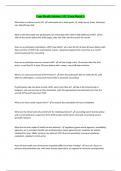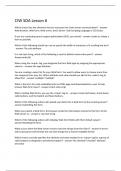Chapter - 01 Limits, Alternatives, and Choices
Brue, McConnell, Flynn
Essentials of Economics 5e
Chapter 1
Limits, Alternatives, and Choices
QUESTIONS
Question 1
Ralph Waldo Emerson once wrote: “Want is a growing giant whom the coat of have was never
large enough to cover.” How does this statement relate to the definition of economics? LO1
Answer
Emerson’s statement reflects the fundamental economic problem of attempting to satisfy
unlimited wants with finite (scarce) economic resources.
Question 2
“Buy 2, get 1 free.” Explain why the “1 free” is free to the buyer but not to society. LO1
Answer
Because an expenditure is not required for the buyer to obtain the “1 free” once she has already
purchased the first two, it is free to the buyer. It is not free to society, however, because
resources were used in producing the third unit that could have been directed to alternate uses.
Question 3
What is an opportunity cost? How does the idea relate to the definition of economics? Which of
the following decisions would entail the greater opportunity cost: Allocating a square block in
the heart of New York City for a surface parking lot or allocating a square block at the edge of a
typical suburb for such a lot? Explain. LO1
Answer
An opportunity cost is what was sacrificed to do or acquire something else. The condition of
scarcity creates opportunity cost. If there was no scarcity, there would be no need to sacrifice one
thing to acquire another. The opportunity cost would be much higher in New York City as the
alternative uses for that square block are much more valuable than for a typical suburban city
block.
Question 4
What is “utility” and how does the idea relate to purposeful behavior? LO1
1-1
,Chapter - 01 Limits, Alternatives, and Choices
Answer
“Utility” refers to the pleasure, happiness, or satisfaction gained from engaging in an activity
(eating a meal, attending a ball game, etc.). It is an important component of purposeful behavior
because people will allocate their scarce time, energy, and money in an attempt to gain the most
utility possible.
Question 5
Cite three examples of recent decisions that you made in which you, at least implicitly, weighed
marginal cost and marginal benefit. LO1
Answer
Student answers will vary but may include the decision to come to class, to skip breakfast to get
a few extra minutes of sleep, to attend college, or to make a purchase. Marginal benefits of
attending class may include the acquisition of knowledge, participation in discussion, and better
preparation for an upcoming examination. Marginal costs may include lost opportunities for
sleep, meals, or studying for other classes. In evaluating the discussion of marginal benefits and
marginal costs, be careful to watch for sunk costs offered as a rationale for marginal decisions.
Question 6
What are the key elements of the scientific method, and how does this method relate to economic
principles and laws? LO2
Answer
The key elements include the gathering of data (observation), the formulation of possible
explanations (hypothesis), testing the hypothesis, determining the validity of the hypothesis, and
repeated testing of hypotheses that have appeared to be valid in prior tests.
The scientific method is the technique used by economists to determine economic laws or
principles. These laws or principles are formulated to explain and/or predict behavior of
individuals or institutions.
Question 7
Indicate whether each of the following statements applies to microeconomics or
macroeconomics: LO3
a. The unemployment rate in the United States was 3.7 percent in December 2018.
b. A U.S. software firm laid off 15 workers last month and transferred the work to India.
c. An unexpected freeze in central Florida reduced the citrus crop and caused the price of
oranges to rise.
d. U.S. output, adjusted for inflation, grew by 3 percent in 2017.
e. Last week Wells Fargo Bank lowered its interest rate on business loans by one-half of 1
percentage point.
f. The consumer price index rose by 2.2 percent from November 2017 to November 2018.
1-2
,Chapter - 01 Limits, Alternatives, and Choices
Answer
Microeconomics examines the decision making of specific economic units or institutions.
Macroeconomics looks at the economy as a whole or its major aggregates.
a. The unemployment rate in the United States was 5.1 percent in September 2015.
Macroeconomics looks at the economy as a whole or its major aggregates (unemployment).
b. A U.S. software firm discharged 15 workers last month and transferred the work to India.
Microeconomics examines the decision making of specific economic units or institutions (a
software firm).
c. An unexpected freeze in central Florida reduced the citrus crop and caused the price of
oranges to rise. Microeconomics examines the decision making of specific economic units or
institutions (citrus market).
d. U.S. output, adjusted for inflation, decreased by 2.4 percent in 2014. Macroeconomics looks at
the economy as a whole or its major aggregates (U.S. output).
e. Last week Wells Fargo Bank lowered its interest rate on business loans by one-half of 1
percentage point. Microeconomics examines the decision making of specific economic units or
institutions (one bank).
f. The consumer price index rose by 0.2 percent from August 2014 to August 2015.
Macroeconomics looks at the economy as a whole or its major aggregates (inflation).
Question 8
What are economic resources? What categories do economists use to classify them? Why are
resources also called factors of production? Why are they called inputs? LO5
Answer
Economic resources are the natural, human, and manufactured inputs used to produce goods and
services. Economic resources fall into four main categories: labor, land (natural resources), real
capital (machines, factories, buildings, etc.), and entrepreneurs. Economic resources are also
called factors of production because they are used to produce goods and services. They are called
inputs because they go into a production process (like ingredients go into a bowl to make a cake),
with the resulting goods and services also being referred to as output.
Question 9
Why is money not considered to be a capital resource in economics? Why is entrepreneurial
ability considered a category of economic resource, distinct from labor? What roles do
entrepreneurs play in the economy? LO5
1-3
, Chapter - 01 Limits, Alternatives, and Choices
Answer
Money is not considered a capital resource because money is not productive – it provides access
to resources but itself does not directly contribute to the production of goods and services.
Additionally, the quantity of money in circulation does not determine an economy’s productive
capacity, while the amount of capital and other resources does.Doubling the amount of money in
circulation does not change the economy’s physical capacity to produce goods and
services.Money is, however, referred as a financial resource and financial capital, reflecting its
ability to acquire real economic resources.
Entrepreneurial ability and labor are both human resources, but they perform different functions
in the productive process.Entrepreneurial ability does not directly produce goods and services; it
organizes the resources that do.Labor refers to the human inputs that directly engage in
production.
Entrepreneurs are risk-takers:They coordinate the activities of the other three inputs for profit—
or loss, which is why they are called risk-takers.Entrepreneurs sometimes manage companies
that they own, but a manager who is not an owner is not necessarily an entrepreneur but may be
performing some of the entrepreneurial functions for the company.Entrepreneurs are also
innovators, or perhaps inventors, and profits help to motivate such activities.
Question 10
Explain the typical shapes of marginal-benefit and marginal-cost curves. How are these curves
used to determine the optimal allocation of resources to a particular product? If current output is
such that marginal cost exceeds marginal benefit, should more or fewer resources be allocated to
this product? Explain.
Answer
The marginal benefit curve is downward sloping, MB falls as more of a product is consumed
because additional units of a good yield less satisfaction than previous units.The marginal cost
curve is upward sloping, MC increases as more of a product is produced since additional units
require the use of increasingly unsuitable resource. The optimal amount of a particular product
occurs where MB equals MC. If MC exceeds MB, fewer resources should be allocated to this use
The resources are more valuable in some alternative use (as reflected in the higher MC) than in
this use (as reflected in the lower MB).
Question 11
Explain how (if at all) each of the following events affects the location of a country’s production
possibilities curve:
a. The quality of education increases.
b. The number of unemployed workers increases.
c. A new technique improves the efficiency of extracting copper from ore.d. A devastating
earthquake destroys numerous production facilities. LO6
1-4







